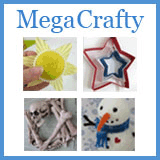
Earlier this week I posted part 1 on how to etch your own glass using a simple paper punch stencil technique. Since I covered the basic steps last time, my project today is a little more intricate. But the technique can be adjusted to make a piece that's more or less detailed depending on what you're comfortable with.
I made the "stencil" for this all over floral pattern using nothing more than a craft knife, masking tape and a permanent marker.
Not only is it cheap on materials but you can create something completely custom instead of having to use a pre-made vinyl stencil.
I started by covering this piece of glass completely with masking tape.


I wrapped the tape around the glass horizontally, overlapping the seams by about half an inch to be sure the tape can't be torn away during cutting (which would expose the glass to acid in areas I might not want etched).
At this point I started to draw a design onto the tape with a permanent marker.

Alternatively: If you aren't comfortable freehand drawing your design you could cover the outside of glass with clear vinyl. Place a pattern inside the glass and trace it onto the vinyl with a marker.

Once I was happy with the pattern I began cutting with the craft knife. Again I wore surgical gloves to keep the oils from my hands off the clean glass.

Tip: The sharper the blade the better. Don't worry about scratching the glass, you want a sharp blade to cut the tape easily. Also you'll be less likely to hurt yourself if you use a sharp blade because the knife won't tear thru the tape and skip off the surface- it will slice thru with more control.
Be careful at this point (not only because you're using s sharp blade) but because what you cut is what you get.
If you do make a mistake you can always retape that section.
Again you can make this as detailed (or not) as you want.

And remember that you're etched piece will be the reverse of your stencil. Here the cut areas are open, once etched they will be the frosted areas.

Etching this way takes advantage of the Armour Etch's strengths and hides it's weaknesses. Since it's a cream it can be put onto very specific areas but the manufacturer recommends etching areas smaller than 1 inch by 1 inch. Larger areas won't etch evenly. If I wanted to leave the branches and flowers clear and etch the rest of the glass I'd need to use an acid bath. (you can by acid bath from this same company).

This is a pretty big piece of glass, and I won't lie. I'm a detail person- I liked cutting all these little buds and branches out. But I'm not a patient person- filling in all these little areas with the etching cream (while wearing gloves and goggles and sitting on my front steps) seemed pretty tedious. I was hurrying because you have to wash the entire piece off at the same time and I wanted to ensure even etching all the way around- but it still seemed to take forever.

Etched, rinsed and cleaned I think it makes a nice addition to the side table in the living room.

It also makes a good candle holder.

Thanks for reading, and I hope after seeing how easy it can be that you give glass etching a try.
Have a great day!










































